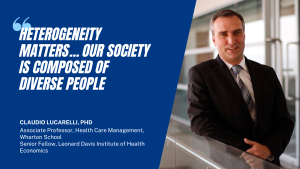S2E2: Is Cost-Effectiveness Enough? (Claudio Lucarelli)
Listen now on Apple Podcasts and Spotify!
In today’s episode, Claudio Lucarelli advocates for more nuance in cost-effectiveness measures.
Lucarelli is an Associate Professor of Health Care Management at The Wharton School and a Senior Fellow at the Leonard Davis Institute for Health Economics at the University of Pennsylvania. He studies the importance of heterogeneity in preferences in the construction of the measurements we use to decide if a medication is worth its cost. Join our conversation with him about cost-effectiveness and heterogeneity!
The paper we discuss can be found here

00:00:00 – 00:40:00. Intro
00:40:01 – 00:02:02. “Cost-effectiveness” is a term thrown around in many conversations about improving healthcare. One of the best-known users of what is formally known as cost-benefit analysis is the United Kingdom’s National Institute for Health and Clinical Excellence (NICE). NICE assesses a technology’s cost per incremental unit of benefit to appraise the technology which can be medications, medical devices, surgical procedures, and more. If NICE recommends the technology, the National Health Service (NHS), is legally obliged to fund and resource that medicine or treatment.
00:02:03 – 00:02:29. We introduce our guest Claudio Lucarelli, PhD who is an Associate Professor of Healthcare Management at The Wharton School at the University of Pennsylvania.
00:02:30 – 00:03:44. Professor Lucarelli discusses what he thinks is currently missing in our current use of cost-effectiveness.
00:03:45 – 0:06:01. Quality-Adjusted Life Years (QALYs) is a metric used to represent the number of healthy years of life a disease takes away or that a treatment returns. Daniel and Professor Lucarelli talk about how it’s used in cost-effectiveness analyses.
00:06:02 – 00:10:35. Professor Lucarelli talks about his paper in which he and his co-authors constructed quality-adjusted price indices for colorectal cancer treatments.
00:10:36 – 00:18:42. Professor Lucarelli and his co-authors chose to study colorectal drugs. They chose these drugs because there was a lot of innovation in this market during their study period and physician are the ones shopping in this market. Daniel and Prof. Lucarelli discuss this.
00:18:43 – 00:22:48. Daniel spends some time highlighting the method “Instrumental Variables”, and talks with Prof. Lucarelli about how they utilized this in his paper.
00:22:49 – 00:30:20. Daniel and Prof. Lucarelli discuss how he and his co-authors used multiple methods to construct a model that not only accurately captures the relationship between drug prices and physician demand to create price indices, but also captures different attributes about drugs like side effects and methods of administration, and even heterogeneity in patient preferences about which kind of drugs they would prefer.
00:30:21 – 00:36:05. Prof. Lucarelli talks about his findings, what does the market for colorectal drugs tell us about how we should think about price indices?
00:36:06 – 00:37:40. Outro
References
